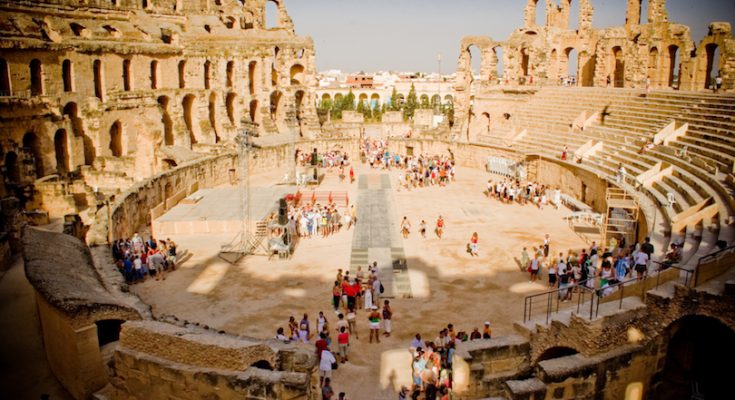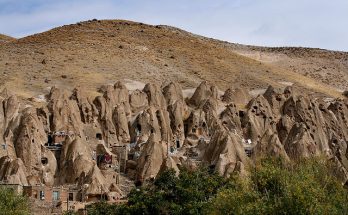At its zenith, the Roman Empire stretched from Morocco and Portugal in the west all the way to Egypt and Armenia in the east. Founded in 27 BC, the empire and its later continuation – the Byzantine Empire – finally collapsed in 1453 AD when the great city of Constantinople was lost to the Ottomans.
Due to the vast territory it encompassed and the incredible number of years it endured, the Roman Empire left behind a host of impressive ruins. While their heyday has long gone, these now act as important historical landmarks and popular tourist attractions.
10. Aqueduct of Segovia[SEE MAP]
Lying in the historic heart of Segovia in Spain, this wonderful aqueduct is one of the best-preserved and best-looking structures of its kind. Believed to have been built by the Romans sometime around 110 AD, it was used to transport water from the nearby mountains to the city and its citizens.
The two-tiered aqueduct features some beautiful brickwork, and at its tallest point, reaches 28.5 meters. In total, the aqueduct boasts 88 elegant arches, all of which have stood the test of time.
9. Tower of Hercules[SEE MAP]
Reputed to be the oldest working lighthouse in the world, the Tower of Hercules has overlooked Spain’s wild and rugged North Atlantic coastline since at least the second century AD. This was when it was built by the Romans, who based its design on the legendary Lighthouse of Alexandria.
Towering to 55 meters, the sturdy-looking tower was last renovated in 1791, when the old Roman masonry was repaired. Set in a scenic spot on a peninsular in Galicia, the endless sea stretching away before the Tower of Hercules saw the region named Finisterra by the Romans, who believed it to be the edge of the world.

One of the largest surviving Roman amphitheatres, Pula Arena makes for a spectacular sight, as it still retains its complete circuit of glimmering, white, limestone walls. Built between 27 BC and 68 AD, the well-preserved arena boasts hundreds of magnificent arches, set over two or three stories.
In its heyday, it would have been able to accommodate up to 23,000 cheering spectators. In addition, there are some fantastic subterranean galleries for visitors to explore, as well as four towers – one at each corner. Beautifully illuminated at night, the arena still regularly hosts events, although nowadays, it’s rock bands and opera singers instead of gladiators who take to the stage in Croatia.
7. Library of Celsus[SEE MAP]
Located in the ancient Greek city of Ephesus in present-day Turkey, the Library of Celsus is rightly exalted for its exquisite architecture. One of the only remaining libraries from the Roman Empire, it was built sometime around 120 AD as a funerary monument to Gaius Julius Aquila’s father.
While most of the building was destroyed long ago in a fire, its fabulous facade with its fine details and stunning statues was re-erected in the 1970s. Believed to have held a vast collection of scrolls, the lovely Library of Celsus was once one of the largest libraries in the empire.
Now, however, it makes for a popular tourist destination and looks particularly arresting when lit up beneath the night sky.
6. Diocletian’s Palace[SEE MAP]
Built to be an extravagant and luxurious retirement home for the Roman emperor Diocletian, this well-preserved palace and its adjoining fort now make up almost half of Split’s old town. The massive complex is fascinating to wander around; large towers and sturdy gates can be found alongside elaborate facades, all built out of shimmering white limestone and marble.
Lying along the city’s waterfront are the emperor’s apartments, which have some fantastic halls and temples for visitors to check out, as well as a monumental central court. Built over a number of decades during the third and fourth centuries, the Diocletian’s Palace is now one of Croatia’s most visited monuments.
5. Amphitheater of El Djem[SEE MAP]
One of the largest and best-preserved Roman ruins around, the Amphitheatre of El Djem can now be found in the Tunisian city of the same name. Built around 238 AD, the colossal arena used to welcome crowds of up to 35,000 at a time, who came to watch gladiator fights and other public spectacles.
Its huge stone blocks and large arches are still standing to this day, and in times of trouble, the whole town used to retreat to its protective confines. If the astounding amphitheatre appears familiar to you, this may be because it featured in such films as Monty Python’s Life of Brian and Gladiator.
A magnificent engineering achievement, Pont du Gard is the most impressive section of a 50-kilometre-long aqueduct that was built to carry water to Nimes in present-day France. Spanning the width of the Gardon river, it is the highest of all the Roman-era aqueduct bridges, with its three tiers of arches towering to 48.8 meters.
Despite having been built all the way back in the first century AD, it is still very well-preserved as local lords used it as a toll bridge for centuries. Set in a scenic location, the Pont du Gard makes for some fantastic photos and is now a popular tourist attraction and important historical monument.
Ever since it was completed in 125 AD, the Pantheon has been a defining feature of the centre of Rome. Meaning ‘temple of all the gods’ in Latin, the Pantheon started life as a temple and was only converted into a church in the 7th century. Its large Corinthian columns and cavernous dome are well-preserved; this is because it has been in continuous use throughout the centuries and millennia.
Inside, its sparkling marble floors are lined by age-old tombs and chapels, with beautiful paintings and sculptures interspersed among them. Having played an enormously influential role in Western architecture, the Pantheon’s gorgeous columns and portico, with the dome atop, have been replicated innumerable times around the globe.
Once known as Heliopolis – the City of the Sun – Baalbek’s sprawling complex is home to some of the most impressive Roman ruins around. Of these, the two largest and grandest are the Temple of Bacchus and the Temple of Jupiter; both of which date to around the first and second century BC.
While they feature some glorious architecture with gigantic colonnades of sturdy columns, the rest of the complex has some marvelous remains and ruins for visitors to peruse. The Great Court, for instance, is littered with stone blocks and carvings dating back millennia, while ancient fortifications can be seen here and there.
Although the site was pilfered over the centuries for building materials by the Mamluks and Ottomans, Baalbek is still a significant historical site and is one of Lebanon’s most popular tourist attractions.

One of the most famous buildings ever constructed, the Colosseum almost needs no introduction. Lying in the heart of Rome, the enormous oval amphitheater is one of the Roman empire’s greatest architectural triumphs and remains standing almost 2000 years after it was completed.
While three stories of huge arcades make up its outer wall, its interior boasts fantastic views of the endless seating areas and subterranean network of tunnels and rooms, which used to lie beneath the arena’s floor. Over the centuries, countless gladiatorial contests, animal hunts, and even mock sea battles took place in the amphitheater, which could hold up to 80,000 spectators.
One of the most iconic symbols of Imperial Rome, the Colosseum is a must-see sight due to its awe-inspiring architecture, spectacular size, and historical importance.



